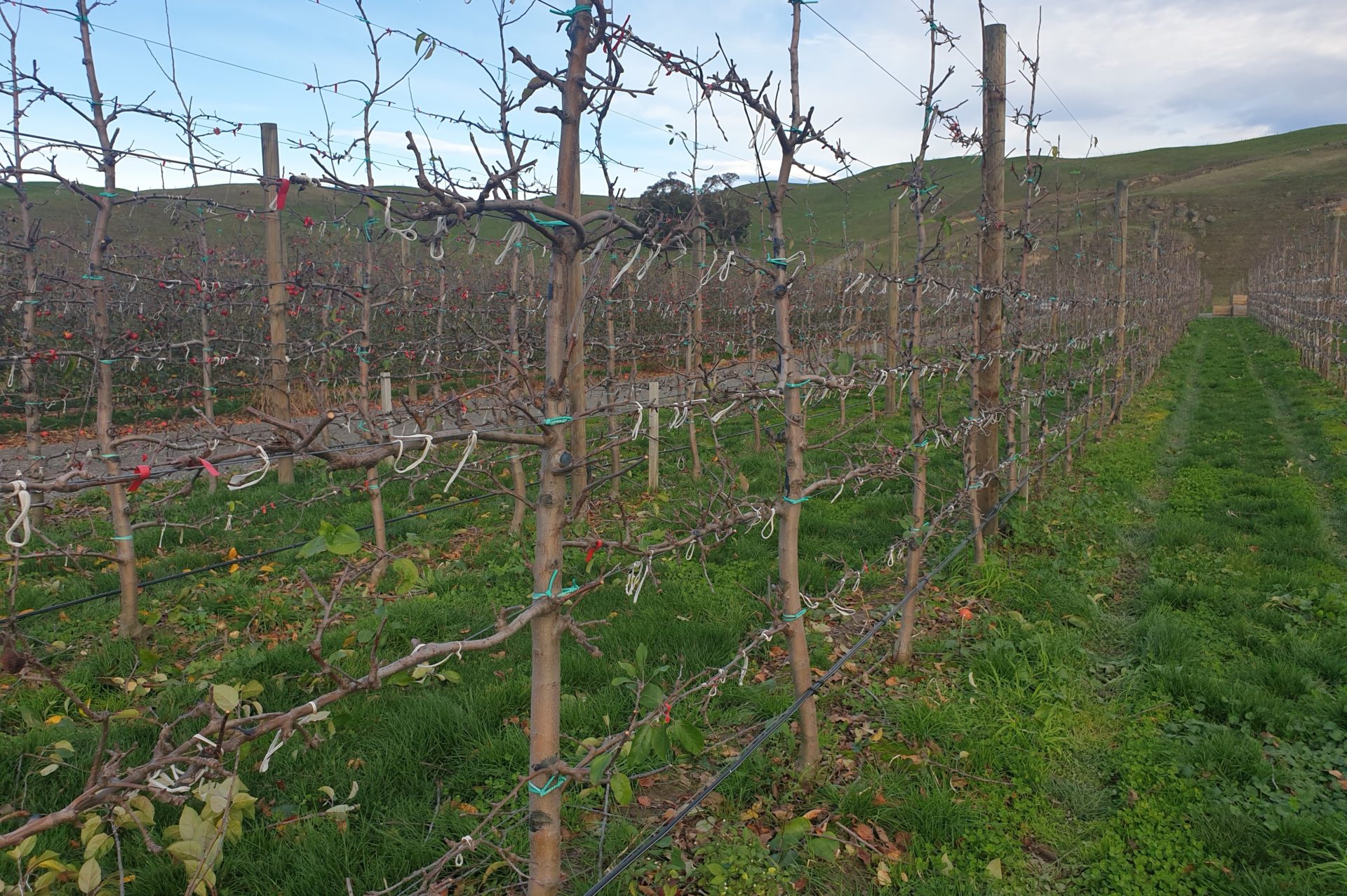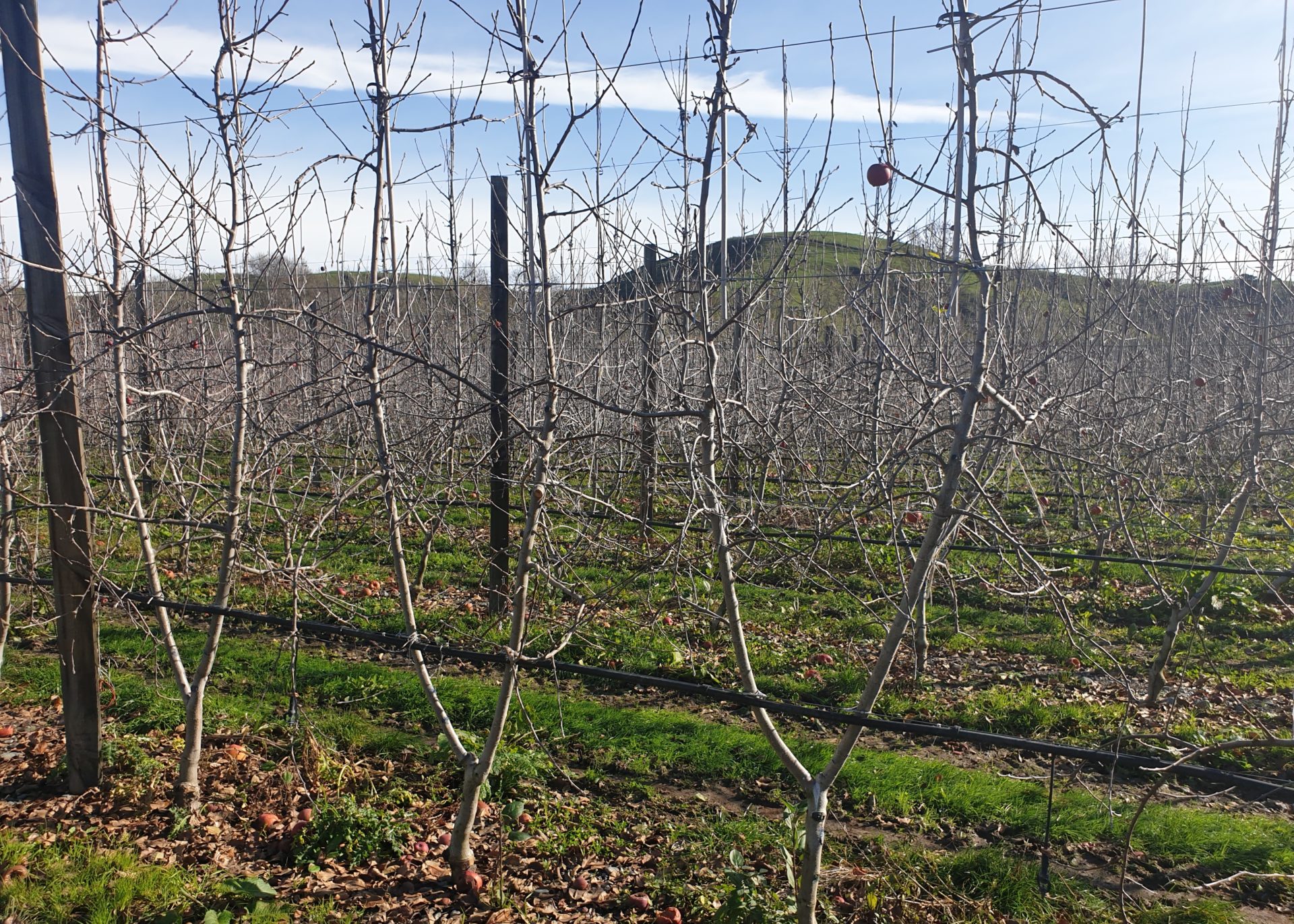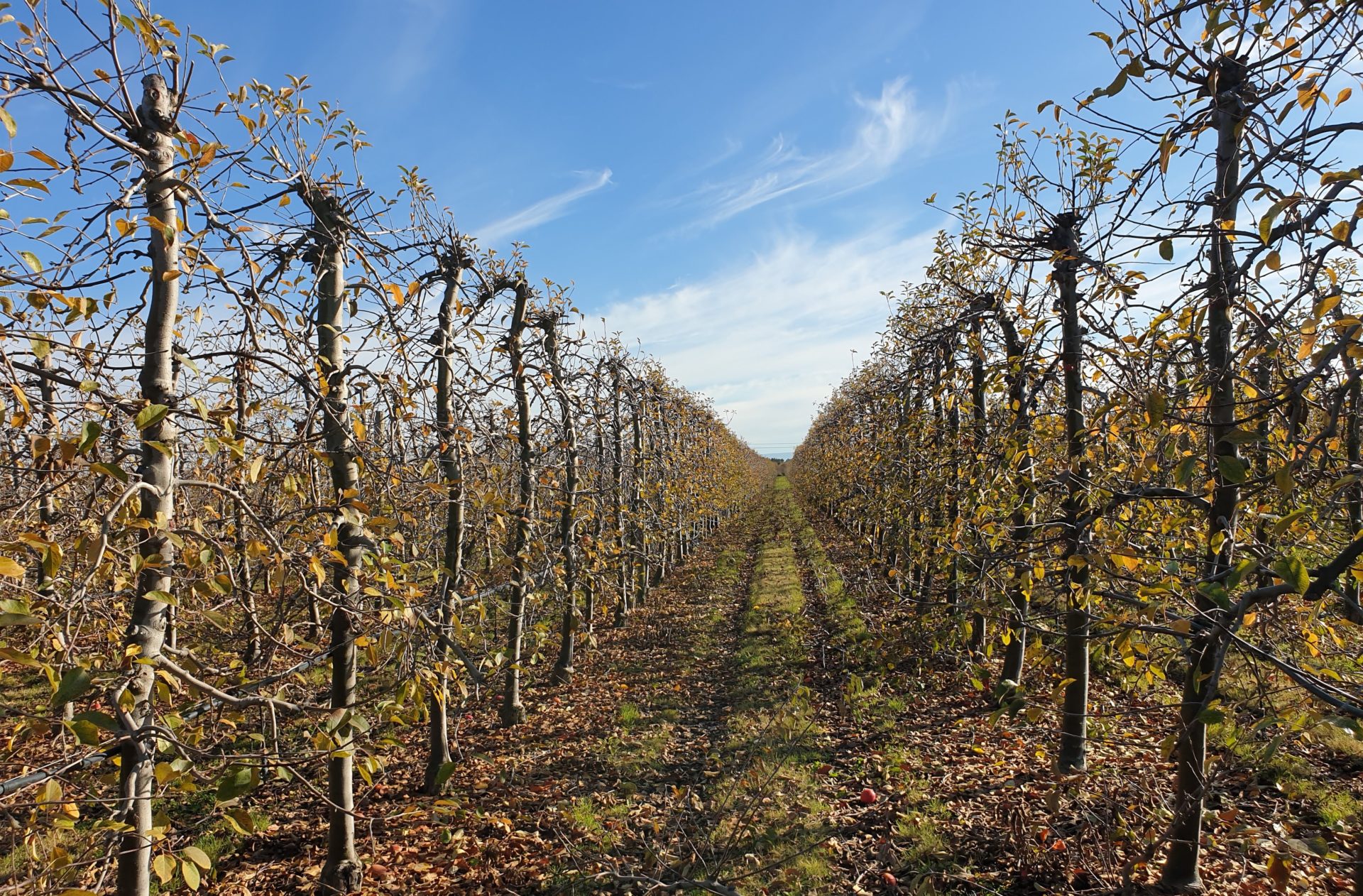Apple growing systems – innovation central
As first seen in the Orchardist, November 2021
Jack Hughes, Horticultural Consultant, Fruition , Hawke’s Bay
Has there ever been a time when the apple industry has been planting new orchards on so many different growing systems? Don’t think so. The creative energy and diversity are great. It does beg a question – is there one system that’s better than the rest? Or with the right management, can any of them excel?
Figure 1 – 2D Jugala
In this article, I will discuss the fundamentals that will determine the answer to this question. To kick off, I have assumed that the fundamentals are:
- Economic efficiency – the time value of money,
- The rate of yield accumulation and the level of peak yield,
- Labour efficiency,
- The ease of maintaining of balanced canopies.
Let’s explore these inter-related factors.
Economic efficiency
The internal rate of return calculation (IRR) is one of the best ways to compare the return on an investment. It considers the net present value of all cash flows (both positive and negative) from an investment (in this case a growing system).
IRR is a good measure because it combines all the inputs and outputs into one number – making comparing different options easy. Its also good because it accounts for a fundamental reality – the time value of money. The more that is spent early on either as capital development or labour, the greater the impact on IRR.
This hard reality can be interpreted in different ways. Glass half full says its ok to invest big in systems that require a lot of infrastructure and tree training because that will make life easier down the track. Glass half empty says be frugal with set-up expenditure because you’ve got to be sure you can pay it back, plus some. The big-ticket items here are:
- The cost of trees – planting density,
- Support structures – whether crop load bearing,
- Canopy design – the time input required for tree training and maintenance.
We’ll come back to these.
The rate and level of yield accumulation
The faster a new orchard gets into production and the higher that yield, the better, right? Yes, so long as fruit value is not compromised at the expense of high yield and so long as these big yields don’t mess up the trajectory of getting and staying there. Managing crop load over the establishment years to produce the highest value crop without compromising the rate of canopy development is a critical element of success.
Labour ease and efficiency
Figure 2 – High density versus trellis
We have to expect the double whammy of the cost of labour continuing to go up and the availability of skilled labour continuing to decline. This new normal increases the inherent value of growing systems that minimise the total labour requirement and the level of skill required. Arguably this factor will only continue to grow in importance over time.
A system’s suitability for mobile work platforms is a factor here. The main advantage of platforms is that they broaden the pool of people that can participate. While that is a worthwhile benefit, we are still assessing whether platforms deliver an economic gain after their cost of capital.
The plot thickens if time critical jobs can’t be completed when they need to be and there is a high downstream cost. For example, this applies to systems that require fruiting wood to be tied down as it grows. It hurts if that window is missed, wood that has got too big to be trained has to be pruned out. This is where there is value in growing systems that have simplicity and flexibility built into their design. This is leads into the next factor of system design.
Simple balanced canopies
Figure 3 – FOPs at Rockit Orchard Limited Partnership, Home Orchard
All of the new growing systems have canopies that are narrower or more planar than their 3D predecessors. Planar canopies lend themselves to better light penetration and easier access for labour efficiency. Platform compatibility is a plus for growing systems with row widths and canopy depths that suit them.
The new planar canopies use different options for the orientation of fruiting wood:
- Horizontal ie 2D (figure 1), V (figure 2)
- Vertical ie FOPs (figure 3)
- Free form ie 3D, Twin stem (figure 4), Hedged (figure 5)
Here we’re focusing on the fruiting wood rather than the tree’s structure. In 2D and V, the fruiting wood coming from the vertical main stem is tied down onto horizontal wires. In FOPs the main scaffold stem is horizontal and the slim fruiting branches are vertical.
Figure 4 – Twin stem Aztec Fuji
Traditional Tall Spindle 3D uses replaceable fruiting branches coming from the vertical main stem. They are often initially tied down into a pendant position and are ‘free form’ after that. Twin stems are essentially smaller versions of the same thing with 2 leaders instead of one. Mechanically hedged or ‘fruiting wall’ canopies can be either single or twin stem with the difference that the canopy profile is trimmed to pre-determined dimensions.
New shoot growth tends to be vertical, so the question with respect to simple, efficient canopy management is, how much of that new growth can be kept and used and to what extent does it need to be modified? It’s a downside if most new growth has to be repeatedly removed or manually trained. This appears to be an additional and ongoing cost with the systems that use horizontal fruiting wood.
The easy to ask but hard to answer question is ‘What does it take to establish each growing system and then how easy is it to maintain it? There is this conundrum that ‘simple in design’ and ‘easy to manage’ are not the exact same thing.
Figure 5 – Mature hedged canopy
Big ticket items
Let’s consider some of the major capital and development items in a bit more detail – the trees, their training and the structures that support them.
Does the structure carry the crop load?
Dwarf rootstocks are not self-supporting and the trees growing on them require trellising to hold them upright and straight. This support ideally should extend to the tops of trees to allow weak wood near the tops to carry fruit. It’s important to keep the whole canopy vertical and prevent the start of a lean that can lead to catastrophic breakage of whole rows.
If the weight of the crop is borne on the structure, then the engineering specification and spacing of the posts and wire must increase. Naturally this affects the whole cost which is an important factor influencing payback and IRR.
Tree density
Tree density also is a big influencer of establishment cost. The rate of yield accumulation in the early years is a largely function of tree density. While higher tree densities favour more rapid yield accumulation, unless this additional expenditure is back by extra yields in the early years, the money is wasted.
There aren’t black and white definitions of relative density but, in today’s context, let’s assume that less than 2,000 trees per hectare is low density, 2-3,000 is moderate while north of 3,000 is high.
If high tree densities lead to crowding and shade problems later in the life of the orchard, then hindsight says the density is too high. By the way, it’s a fallacy that tree to tree (or root to root) competition in very high-density situations reduces overall vegetative vigour.
Low tree density favours a settled balance in mature canopies because each root system is supporting relatively large canopy. This factor has been incorporated into the design of the FOPs system which uses tree densities of less than 2,000 trees/ha. There is the element of the hare and tortoise in this race with FOPs being a little slower out of the blocks but finishing strongly.
Rate of canopy development
The rate of canopy establishment underpins yield accumulation, and this is not directly linked to tree density. The genetics of the rootstock clearly influences growth rate and precocity as does the way the tree is pruned and trained from the time it is planted. If, for example, a standard, single stem nursery tree needs to be cut back at planting to regrow two new leaders, then there is an expensive set-back of involved.
Years ago, there used to be pressure put on nurseries to produce trees with useable branches. If trees had enough useful branches, above a required minimum height and with flat angles, they would be well set-up to produce fruit from the spurs that developed on these branches in their second leaf. The engine for early yield accumulation.
The trend now is to remove all the branches at planting and start with a rod. Sure, this may be justified when branches aren’t consistent, or the trees aren’t well grown or graded. Achieving uniformity in a block from the outset is important for downstream management.
The fun question to ask is ‘what growing system would you go with if you were
180 tonnes per hectare
FOP’s is unique with its combination of ultra-narrow canopy and very narrow rows that give the systems its fruiting capacity. The published yields are extra-ordinary so the system can’t be overlooked but it is a big commitment system in terms of capital and labour input. This includes the load bearing support structures and the installation of bamboo poles to train each of the 17,000/ha upright fruiting branches.
Optimising the system also requires manual bud thinning in winter and hand thinning of the crop as chemical thinning is deemed too risky on the ‘easily shifted’ vertical stems. These different approaches challenge conventional thinking.
Other important factors
Protecting the crop from hail and sunburn with overhead netting must be considered given the financial investment at stake, the increasing cost of insurance and the desirability of ensuring customer supply. How suited is each growing system to net installation either from scratch or retro fitted as the crop comes in?
Table 1 – Typical metrics and features of different growing systems
Market access and disease risk are also important factors. Apple leaf curling midge (ALCM) and woolly apple aphid (WAA) are zero tolerance pests for sensitive markets, so it makes sense to minimise the risk of incidence. Late season ALCM populations are closely linked to the presence of their preferred habitat i.e., actively growing shoots. A growing system that reliably terminates extension growth by Christmas fits the bill here.
Rootstock susceptibility to WAA influences the populations of this pest. M9 clones are WAA susceptible and Geneva stocks are not, so there is a clear choice here. The same applies to fireblight. M9 represents an inherent risk with this episodic disease that can wreck orchards in the bad years. What value should be put on the hardwired fireblight resistance of Geneva 202 and its lower vigour cousin, Geneva 41?
The factors discussed in this article are summarised in Table 1. They are not ‘hard and fast’ and are up for debate. The fun question to ask is ‘what growing system would you go with if you were planting a block?’





